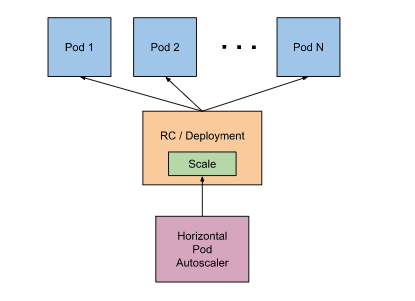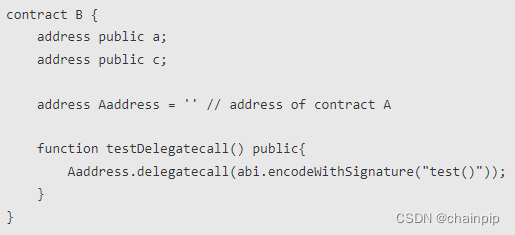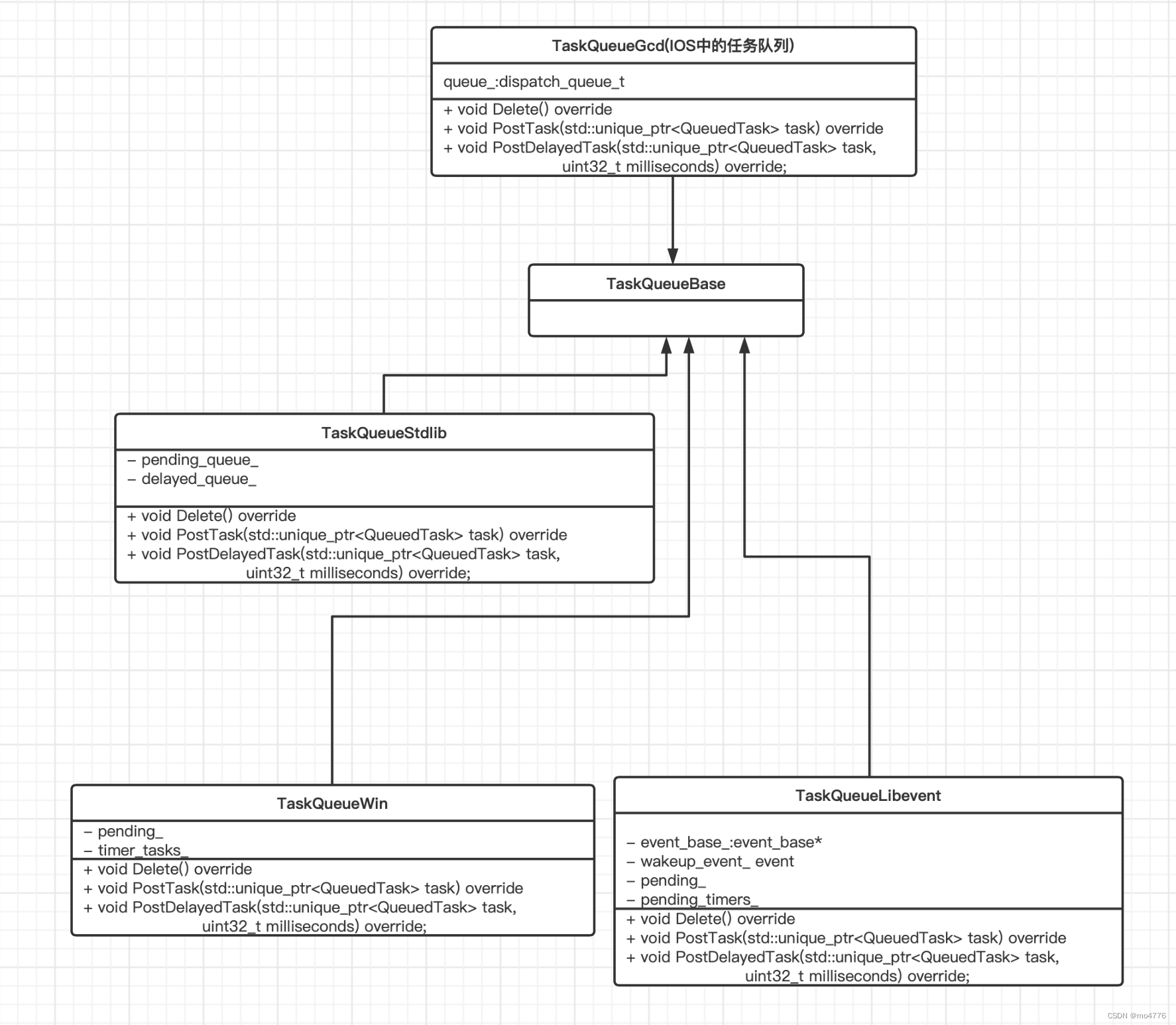当前位置:网站首页>(十)树的基础部分(一)
(十)树的基础部分(一)
2022-08-04 05:28:00 【顺毛黑起】
为什么需要树这种数据结构
数组存储方式的分析
优点:通过下标方式访问元素,速度快。对于有序数组,还可使用二分查找提高检索速度。(可以快速访问某个元素,通过索引)
缺点:如果要检索具体某个值,或者插入值(按一定顺序)会整体移动,效率较低(不适用于添加和删除元素,数组整体移动)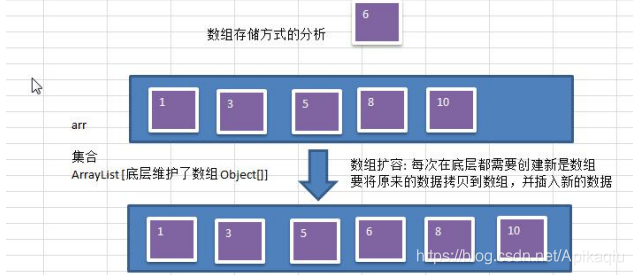
链式存储方式的分析
优点:在一定程度上对数组存储方式有优化(比如:插入一个数值节点,只需要将插入节点,链接到链表中即可,删除效率也很好)。
缺点:在进行检索时,效率仍然较低,比如(检索某个值,需要从头节点开始遍历)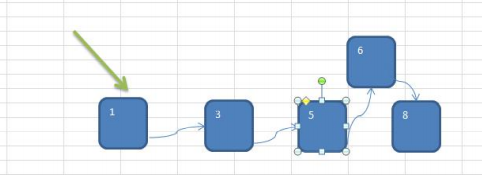
树存储方式的分析
能提高数据存储,读取的效率, 比如利用 二叉排序树(Binary Sort Tree),既可以保证数据的检索速度,同时也可以保证数据的插入,删除,修改的速度。
树的基本概念
结点的度“该结点拥有的子结点的个数。非终端结点的度不为0.
树的度:该树中,结点度数的最大值。
叶节点:结点的度为0.(终端结点)
树的深度:层数(以根节点为第一层)
有序树:对于孩子结点,不能随意交换,交换后是另一棵树。
二叉树
二叉树的性质
性质1 在二叉树的第i层上至多有2^(i-1)个结点(i>=1)
性质2 深度为k的二叉树至多有2^k-1个结点(k>=1)
性质3 对任何一个二叉树T,如果其终端结点数为m,度为2的结点数为n,则m=n+1
性质4 具有n个结点的完全二叉树的深度为log以2为底n的对数向上取整再加1
性质5 如果对一棵有n个结点的完全二叉树(其深度为log以2为底n的对数向上取整再加1)的节点按层编号(从第一层到第log以2为底n的对数向上取整再加1层,每层从左到右),则对任一结点i(1<=i<=n),有:
(1)如果i=1,则结点i是二叉树的根,无双亲;如果i>1,则其双亲PARENT(i)是结点 ((i/2)向上取整)
(2) 如果2i大于n,则结点i无左孩子(结点i为叶子结点);否则其左孩子LCHILD(i)是结点2i。
(3)如果2i+1>n,则结点i无右孩子;否则其右孩子RCHILD(i)是结点(2i+1)

二叉树的遍历
- 前序遍历: 先输出父节点,再遍历左子树和右子树
- 中序遍历: 先遍历左子树,再输出父节点,再遍历右子树
- 后序遍历: 先遍历左子树,再遍历右子树,最后输出父节点
== 看输出父节点的顺序,就确定是前序,中序还是后序==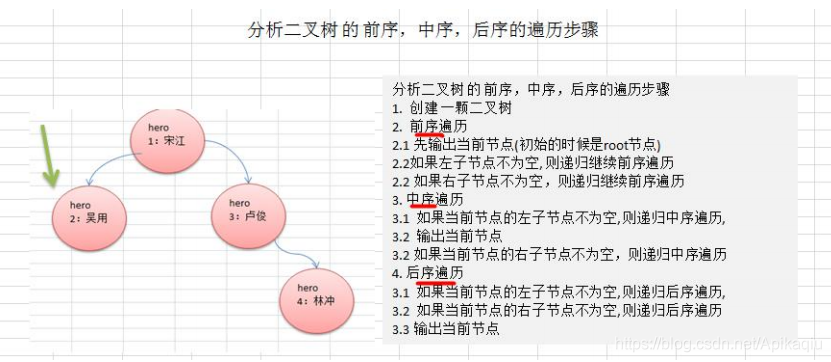
package com.atguigu.tree;
public class BinaryTreeDemo {
public static void main(String[] args) {
//先创建一棵二叉树
BinaryTree binaryTree = new BinaryTree();
//创建需要的结点
HeroNode root=new HeroNode(1,"宋江");
HeroNode node2=new HeroNode(2,"吴用");
HeroNode node3=new HeroNode(3,"卢俊义");
HeroNode node4=new HeroNode(4,"林冲");
//说明:先手动创建二叉树,后面会学习递归创建二叉树
root.setLeft(node2);
root.setRight(node3);
node3.setRight(node4);
binaryTree.setRoot(root);
//前序遍历
System.out.println("前序遍历");//1 2 3 4
binaryTree.preOrder();
//中序遍历
System.out.println("中序遍历");// 2 1 3 4
binaryTree.infixOrder();
//后序遍历
System.out.println("后序遍历");// 2 4 3 1
binaryTree.postOrder();
}
}
//定义BinaryTree二叉树
class BinaryTree{
private HeroNode root;
public void setRoot(HeroNode root){
this.root=root;
}
//HeroNode提供真正遍历的函数,但是该函数由BinaryTree这里来调用
//前序遍历
public void preOrder(){
if (this.root!=null){
this.root.preOrder();
}else {
System.out.println("二叉树为空,无法遍历");
}
}
//中序遍历
public void infixOrder(){
if (this.root!=null){
this.root.infixOrder();
}else {
System.out.println("二叉树为空,无法遍历");
}
}
//后序遍历
public void postOrder(){
if (this.root!=null){
this.root.postOrder();
}else {
System.out.println("二叉树为空,无法遍历");
}
}
}
//先创建HeroNode结点
class HeroNode{
private int no;
private String name;
private HeroNode left;//默认null
private HeroNode right;//默认null
public HeroNode(int no, String name) {
this.no = no;
this.name = name;
}
public int getNo() {
return no;
}
public void setNo(int no) {
this.no = no;
}
public String getName() {
return name;
}
public void setName(String name) {
this.name = name;
}
public HeroNode getLeft() {
return left;
}
public void setLeft(HeroNode left) {
this.left = left;
}
public HeroNode getRight() {
return right;
}
public void setRight(HeroNode right) {
this.right = right;
}
@Override
public String toString() {
return "HeroNode{" +
"no=" + no +
", name='" + name + '\'' +
'}';
}
//前序遍历
public void preOrder(){
System.out.println(this);
//递归向左子树遍历
if (this.left!=null){
this.left.preOrder();
}
//递归向右子树遍历
if (this.right!=null){
this.right.preOrder();
}
}
//中序遍历
public void infixOrder(){
//递归向左子树遍历
if (this.left!=null){
this.left.infixOrder();
}
System.out.println(this);//输出父结点
//递归向右子树遍历
if (this.right!=null){
this.right.infixOrder();
}
}
//后序遍历
public void postOrder(){
//递归向左子树遍历
if (this.left!=null){
this.left.postOrder();
}
//递归向右子树遍历
if (this.right!=null){
this.right.postOrder();
}
System.out.println(this);//输出父结点
}
}
注意:HeroNode提供真正遍历的函数, BinaryTree中的遍历函数只是用来调用HeroNode中的遍历函数
二叉树–查找指定的结点
要求
- 请编写前序查找,中序查找和后序查找的方法。
- 并分别使用三种查找方式,查找 heroNO = 5 的节点
- 并分析各种查找方式,分别比较了多少次
- 思路分析图解
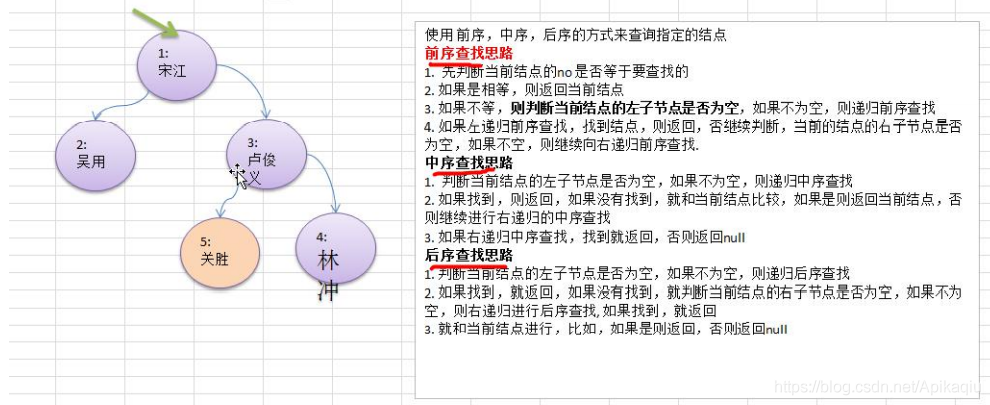
package com.atguigu.tree;
public class BinaryTreeDemo {
public static void main(String[] args) {
//先创建一棵二叉树
BinaryTree binaryTree = new BinaryTree();
//创建需要的结点
HeroNode root=new HeroNode(1,"宋江");
HeroNode node2=new HeroNode(2,"吴用");
HeroNode node3=new HeroNode(3,"卢俊义");
HeroNode node4=new HeroNode(4,"林冲");
HeroNode node5=new HeroNode(5,"关胜");
//说明:先手动创建二叉树,后面会学习递归创建二叉树
root.setLeft(node2);
root.setRight(node3);
node3.setRight(node4);
node3.setLeft(node5);
binaryTree.setRoot(root);
//前序遍历查找
System.out.println("前序遍历查找~~~~~");
HeroNode resNode = binaryTree.preOrderSearch(5);
if (resNode!=null){
System.out.printf("找到了,信息为 no=%d name=%s\n",resNode.getNo(),resNode.getName());
}else {
System.out.printf("没有找到no=%d的英雄",5);
}
}
}
//定义BinaryTree二叉树
class BinaryTree{
private HeroNode root;
public void setRoot(HeroNode root){
this.root=root;
}
//前序遍历查找
public HeroNode preOrderSearch(int no){
if (root!=null){
return root.preOrdersearch(no);
}else {
return null;
}
}
//中序遍历查找
public HeroNode infixOrderSearch(int no){
if (root!=null){
return root.infixOrdersearch(no);
}else {
return null;
}
}
//后序遍历查找
public HeroNode postOrderSearch(int no){
if (root!=null){
return root.postOrdersearch(no);
}else {
return null;
}
}
}
//先创建HeroNode结点
class HeroNode{
private int no;
private String name;
private HeroNode left;//默认null
private HeroNode right;//默认null
public HeroNode(int no, String name) {
this.no = no;
this.name = name;
}
public int getNo() {
return no;
}
public void setNo(int no) {
this.no = no;
}
public String getName() {
return name;
}
public void setName(String name) {
this.name = name;
}
public HeroNode getLeft() {
return left;
}
public void setLeft(HeroNode left) {
this.left = left;
}
public HeroNode getRight() {
return right;
}
public void setRight(HeroNode right) {
this.right = right;
}
@Override
public String toString() {
return "HeroNode{" +
"no=" + no +
", name='" + name + '\'' +
'}';
}
//前序遍历查找
public HeroNode preOrdersearch(int no){
if (this.no==no){
return this;
}
//判断当前结点的左子结点是否为空,不为空则递归前序查找
HeroNode resNode=null;
if (this.left!=null){
resNode= this.left.preOrdersearch(no);
}
if (resNode!=null){
//说明左子树找到
return resNode;
}
//对右结点判断
if (this.right!=null){
resNode=this.right.preOrdersearch(no);
}
return resNode;//此时不管找到还是没有找到,都必须返回
}
//中序遍历查找
public HeroNode infixOrdersearch(int no){
HeroNode resNode=null;
if (this.left!=null){
resNode=this.left.infixOrdersearch(no);
}
if (resNode!=null){
return resNode;
}
if (this.no==no){
return this;
}
if (this.right!=null){
resNode=this.right.infixOrdersearch(no);
}
return resNode;
}
//后序遍历查找
public HeroNode postOrdersearch(int no){
HeroNode resNode=null;
if (this.left!=null){
resNode=this.left.postOrdersearch(no);
}
if (resNode!=null){
return resNode;
}
if (this.right!=null){
resNode=this.right.postOrdersearch(no);
}
if (resNode!=null){
return resNode;
}
if (this.no==no){
return this;
}
return resNode;//resNode最初是null,没有找到则返回resNode,也就是null
}
}
二叉树- 节点的删除
要求
- 如果删除的节点是叶子节点,则删除该节点
- 如果删除的节点是非叶子节点,则删除该子树
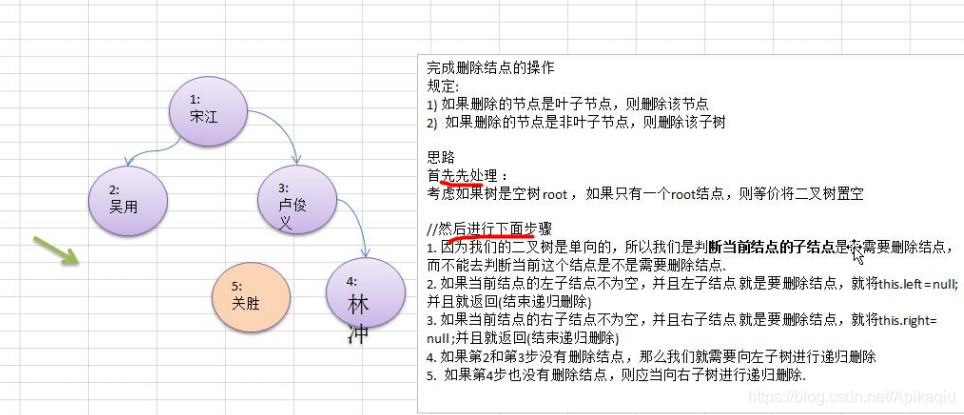
package com.atguigu.tree;
public class BinaryTreeDemo {
public static void main(String[] args) {
//先创建一棵二叉树
BinaryTree binaryTree = new BinaryTree();
//创建需要的结点
HeroNode root=new HeroNode(1,"宋江");
HeroNode node2=new HeroNode(2,"吴用");
HeroNode node3=new HeroNode(3,"卢俊义");
HeroNode node4=new HeroNode(4,"林冲");
HeroNode node5=new HeroNode(5,"关胜");
//说明:先手动创建二叉树,后面会学习递归创建二叉树
root.setLeft(node2);
root.setRight(node3);
node3.setRight(node4);
node3.setLeft(node5);
binaryTree.setRoot(root);
//删除节点
System.out.println("删除前,前序遍历");
binaryTree.preOrder();//1 2 3 5 4
binaryTree.delNode(5);
System.out.println("删除后,前序遍历");
binaryTree.preOrder();//1 2 3 4
}
}
//定义BinaryTree二叉树
class BinaryTree{
private HeroNode root;
public void setRoot(HeroNode root){
this.root=root;
}
//删除节点
public void delNode(int no){
if (root!=null){
//如果只有一个根结点,这里立即判断root是不是就是要删除的结点
if (root.getNo()==no){
root=null;
}else {
//递归删除
root.delNode(no);
}
}else {
System.out.println("空树,不能删除~~~");
}
}
}
//先创建HeroNode结点
class HeroNode{
private int no;
private String name;
private HeroNode left;//默认null
private HeroNode right;//默认null
public HeroNode(int no, String name) {
this.no = no;
this.name = name;
}
public int getNo() {
return no;
}
public void setNo(int no) {
this.no = no;
}
public String getName() {
return name;
}
public void setName(String name) {
this.name = name;
}
public HeroNode getLeft() {
return left;
}
public void setLeft(HeroNode left) {
this.left = left;
}
public HeroNode getRight() {
return right;
}
public void setRight(HeroNode right) {
this.right = right;
}
@Override
public String toString() {
return "HeroNode{" +
"no=" + no +
", name='" + name + '\'' +
'}';
}
//递归删除结点
//1) 如果删除的节点是叶子节点,则删除该节点
//2) 如果删除的节点是非叶子节点,则删除该子树
public void delNode(int no){
if (this.left!=null && this.left.no==no){
this.left=null;
return;
}
if (this.right!=null && this.right.no==no){
this.right=null;
return;
}
if (this.left!=null){
this.left.delNode(no);
}
if (this.right!=null){
this.right.delNode(no);
}
}
}
删除:
1.先对根结点进行判断,是否为空,如果不为空,根结点是否是要删除的结点。
2.(递归函数的编写)先对节点的左孩子和右孩子判断是否是要删除的结点,如果不是,则判断左孩子是否存在,存在则左子树的递归。果果左子树的递归仍然没有找到,同样,则判断右孩子是否存在,存在,则右子树的递归。



